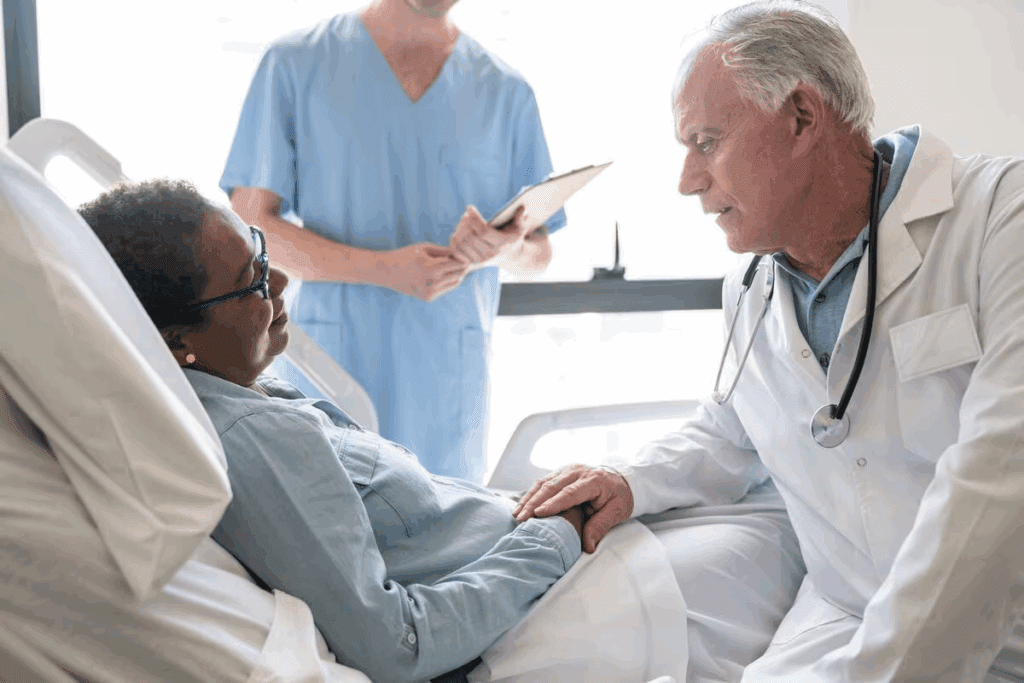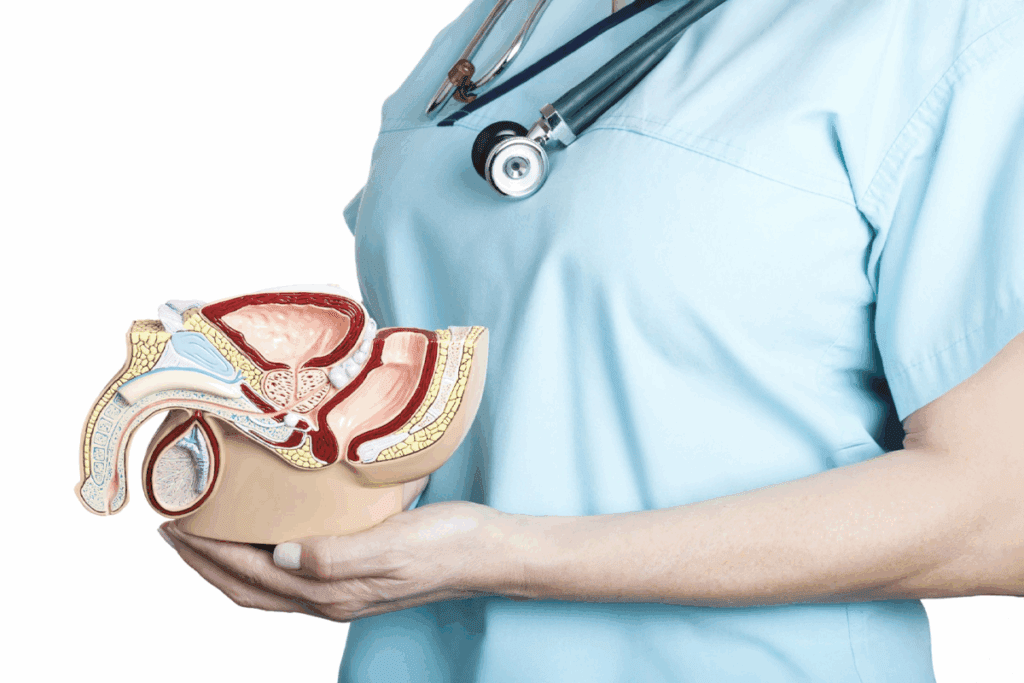Last Updated on November 27, 2025 by Bilal Hasdemir

Button up shirts loose fitting for after surgery Recovering from prostate surgery means paying close attention to what you wear. Comfortable clothing is key to a smooth recovery. It helps you heal faster and regain your strength.
Eric A. Singer, MD, MA, MS, FACS, FASCO, from Ohio State University, says it’s all about quality of life during recovery. The right clothes can lessen discomfort and boost your well-being.
Choosing the right clothes is vital for your recovery. Focus on comfort and practicality when picking what to wear. Find out how long you must avoid driving after prostatectomy for a safe and smooth recovery.

Recovering from prostate surgery means dealing with pain, swelling, and being less mobile. These issues can really affect your daily life. It’s key to know what to expect during recovery.
Patients often feel pain and swelling after prostate surgery. This can make it hard to move around and do everyday tasks. Common physical limitations include:
A medical expert says,
“The key to a successful recovery is managing these physical limitations effectively to minimize discomfort and prevent complications.”
The time it takes to recover from prostate surgery varies. But usually, it takes several weeks. Knowing the general timeline helps patients get ready for recovery.
| Recovery Stage | Typical Duration | Common Experiences |
| Immediate Recovery | 1-2 weeks | Significant discomfort, swelling, and limited mobility |
| Early Recovery | 2-4 weeks | Gradual improvement in mobility, some discomfort persists |
| Late Recovery | 4-6 weeks and beyond | Most patients return to normal activities, some may have minor discomfort |
During recovery, comfort and physical limitations are top priorities. Special considerations include:
Understanding these recovery aspects helps patients prepare for the journey ahead. It guides them in making smart choices about their care.

The clothes you wear during recovery can either help or hurt your healing. Wearing the right clothes can reduce irritation and discomfort. These are key to a smooth recovery.
Clothing that’s too tight can irritate the surgical site, leading to problems. Loose, comfortable clothing helps reduce discomfort and supports healing. Fabrics that breathe and manage moisture also make recovery more comfortable.
Wearing the right clothes is key to avoiding complications like infection or injury. For example, avoiding tight clothing that can rub or put pressure on the surgical area is important. Also, clothes that are easy to change are helpful for incontinence issues.
Comfort is a top priority during recovery, but practicality is also important. Clothes that are easy to put on and take off make a big difference. Button-up shirts and elastic waistbands are good examples. They add comfort without making things hard to use.
Choosing the right clothes can greatly improve your recovery. It helps avoid complications and makes you more comfortable.
Wearing loose-fitting button-up shirts can greatly improve comfort after surgery. The right clothes are key to a smooth recovery. They affect comfort, mobility, and the chance of complications.
Button-up shirts are great after surgery because they’re easy to wear. They let patients dress and undress without pulling over their heads. This is helpful if there’s a surgical site or if they have limited mobility.
Key benefits of button-up designs include:
Choosing the right fabric for post-surgery shirts is important. Look for breathable, soft, and gentle materials for comfort and to avoid irritation.
Cotton and cotton blends are top picks for their breathability and softness. Bamboo or modal are also good choices for their comfort and hypoallergenic properties.
Many brands focus on making clothes for patients recovering from surgery. They offer designs that meet the needs of those healing.
These brands have a variety of styles and sizes. This ensures patients can find shirts that fit their needs during recovery.
The right underwear is key after prostate surgery. It helps manage incontinence and makes recovery easier. Special underwear and pads are designed to support and protect.
Underwear made for post-prostate surgery recovery offers extra support. It’s made from breathable, moisture-wicking materials. These keep the skin dry and prevent irritation.
Key Features to Look for:
Choosing the right pads is vital for managing incontinence. The best pads balance absorbency and comfort.
| Absorbency Level | Description | When to Use |
| Low | For light incontinence, ideal for occasional leakage. | During the later stages of recovery or for minor incontinence issues. |
| Moderate | Suitable for moderate leakage, providing extra protection. | During the initial recovery phase when incontinence is more pronounced. |
| High | For heavy incontinence, showing maximum absorbency. | Immediately after surgery or during periods of high incontinence activity. |
Knowing when to use different absorbency levels helps manage incontinence better. The right choice depends on how severe the incontinence is and the recovery stage.
By picking the right underwear and pads, patients can manage incontinence well. This reduces discomfort and helps focus on recovery.
After prostate surgery, it’s key to wear comfy pants to ease pain and aid healing. The right pants can really help your recovery.
Pants with elastic waistbands are a top pick for post-surgery wear. They’re comfy and don’t have buttons or zippers that can bother the surgical area. Elastic waistbands also adjust and stretch, fitting changes in your body during healing.
“I’ve found that pants with elastic waistbands are a game-changer after surgery. They’re so much more comfortable than traditional waistbands,” says a patient recovering from prostate surgery.
It’s important to avoid putting pressure on the surgical site to help it heal. Tight clothes can cause irritation and discomfort, which might lead to more problems. Wearing loose, soft pants can help avoid these issues. Choose pants that are comfy and don’t put extra stress on the area.
When picking pants for recovery, look for styles that are both comfy and useful. Drawstring pants and sweatpants are great because they’re easy to wear and adjust. Make sure the pants fit well around the thighs and hips to prevent rubbing or chafing.
By choosing pants that are both comfy and practical, you can make your recovery smoother. The right pants can really help how you feel during this time.
Choosing the right shoes is key for a smooth recovery after prostate surgery. The right shoes can prevent falls, reduce pain, and make moving around easier.
When picking shoes after prostate surgery, ease of use is important. Slip-on shoes are great because they’re easy to slip on and off. But, lace-up shoes might offer more support and stability. It’s important to choose what’s best for you.
Here’s a comparison of slip-on and lace-up shoes:
| Feature | Slip-On Shoes | Lace-Up Shoes |
| Ease of Use | High | Medium |
| Support and Stability | Medium | High |
| Comfort | High | High |
Shoes that offer good arch support and non-slip soles are vital. They help prevent falls and injuries. Look for shoes with extra cushioning for more comfort.
For indoor use, slip-on slippers or recovery sandals with a good grip are perfect. They’re comfy and help avoid slipping on smooth floors. Plus, they should be easy to clean and breathable.
Choosing the right shoes can greatly improve your comfort and safety while recovering from prostate surgery.
Choosing the right outerwear is key when recovering from prostate surgery. The right layers help you adjust to temperature changes and reduce discomfort at the surgical site.
During recovery, easy-to-wear outerwear is essential. Jackets and sweaters with simple closures make dressing easier. They should be comfortable and allow for easy access for medical checks.
Opt for lightweight, breathable materials that won’t irritate your skin. Fleece or soft cotton blends are great for warmth without being too heavy.
Layering is important for managing your body temperature during recovery. In cold weather, multiple layers help adjust to indoor and outdoor temperatures. In warm weather, lighter layers prevent overheating.
Keep an eye on the weather forecast and plan your clothes. A versatile wardrobe that can be mixed and matched is very helpful.
Adaptive clothing is made with functionality in mind. It often has features like magnetic closures and adjustable hems. These are great when you have limited mobility and dexterity during recovery.
Some brands focus on adaptive clothing, making stylish and practical options. When shopping, look for clothes that are comfortable, easy to use, and adaptable to your needs during recovery.
Wearing comfortable nightwear is key to better sleep after prostate surgery. The right clothes can greatly help in recovery. Good sleep is vital for healing.
It’s important to pick pajamas that are both comfortable and supportive. Loose-fitting pajamas in soft, breathable fabrics like cotton are best. These styles help avoid irritation and allow for easy movement, which is important for those recovering.
Look for pajamas with these features:
Bedding also affects sleep comfort. Choose hypoallergenic bedding to avoid skin irritation. Also, pick absorbent linens to manage incontinence at night, a common issue after surgery.
Dealing with nighttime incontinence is key for uninterrupted sleep. Use absorbent pads or adult diapers for comfort and security. Remember to change them often to avoid skin irritation.
| Product Type | Absorbency Level | Recommended Use |
| Absorbent Pads | High | For heavy incontinence |
| Adult Diapers | Very High | For maximum protection |
| Liners | Low to Medium | For light incontinence or as a backup |
By focusing on comfortable nightwear and managing incontinence, patients can improve their sleep during recovery.
Recovering from prostate surgery is more than just rest and medicine. It also means wearing the right clothes. You can find these at certain stores and online.
Special clothes for after surgery help you feel better. They offer comfort and support. There are many places to buy these clothes.
Shopping online makes it easy to find post-surgery clothes at home. Some top online stores are:
If you like to shop in person, there are stores for you. You can find:
Check if your insurance covers clothes for after surgery. Some plans do. Medical supply stores often have products that might be covered.
| Store Type | Online/Brick-and-Mortar | Insurance Coverage |
| ABC Medical Supply | Online | Yes |
| Local Medical Supply Stores | Brick-and-Mortar | Yes |
| Recovery Wear Co. | Online | No |
Looking into these options can help you find the right clothes for a smooth recovery.
Understanding the cost of post-surgery clothes is key for a smooth recovery. The price can change a lot based on the type, quality, and brand.
Patients often face a choice between quality, durable clothes and cheaper, temporary ones. Investment pieces like well-made shirts and comfy underwear cost more upfront. But they last longer and are more comfortable.
Temporary solutions might be cheaper but may not last as long. Finding a balance between what you need and what you can afford is important.
Making your recovery clothes versatile can save money. Choosing items that can be worn in different ways can cut costs. For example, elastic waistband pants can go with many tops, making more outfits from fewer pieces.
| Clothing Item | Versatility Score | Cost Range |
| Button-up Shirt | 8/10 | $20-$50 |
| Elastic Waistband Pants | 9/10 | $25-$40 |
| Supportive Underwear | 7/10 | $15-$30 |
For many, the cost of recovery clothes is a big worry. Luckily, there are financial assistance options out there. Some groups offer grants or subsidies for recovery needs, including clothes.
Also, some stores have discounts or special programs for surgery patients. Looking into these can help with the cost of recovery clothes.
Choosing the right clothes can greatly improve your comfort and experience at medical appointments after prostate surgery. It’s important to pick outfits that are both comfortable and easy to examine in.
Practicality is key when getting ready for medical visits. Your clothes should be simple to take off and put back on. This makes the whole process less stressful and uncomfortable.
Loose-fitting garments are great because they allow easy access without irritating the surgical area.
Comfort is a must, but looking good is also important. Choose clothes that are both comfy and clean. Layering helps you adjust to the situation and the need for exams.
Wearing clothes that are easy to change into a gown is helpful. Slip-on shoes and simple, elastic waistbands make changing quicker. Wearing fewer layers also simplifies the process.
Thinking about these points can make medical appointments and follow-ups easier after prostate surgery. By focusing on comfort and practicality, you can make these visits less stressful.
As patients move through their recovery, their clothing needs change a lot. At first, they need comfort and ease. Later, they can choose more varied clothes.
In the first week after prostate surgery, comfort is key. Wear loose, easy clothes that don’t strain your body. Button-up shirts and elastic waistband pants are great for this.
Choose clothes made from breathable fabrics like cotton. They help with discomfort and aid in healing.
By weeks 2 to 4, you can add more variety to your clothes. Comfort is important, but you can wear layers for temperature control. You can also wear clothes that fit a bit better for a sense of normalcy.
| Clothing Item | Features to Look For | Benefits |
| Shirts | Soft fabrics, button-up fronts | Ease of use, comfort |
| Pants | Elastic waistbands, loose fits | Minimizes irritation, comfortable |
After four weeks, most patients are doing well and can wear regular clothes again. They might choose comfort over style. It’s a good time to reintroduce more normal clothing slowly, balancing comfort and style.
Changing your clothes based on your recovery stage can really help. It makes healing and feeling comfortable easier. Knowing what you need at each stage helps you prepare for a smoother recovery.
Recovering from prostate surgery means picking the right clothes carefully. The right clothes can really help your healing process. They make a big difference in how you feel.
Wearing loose, comfy clothes helps a lot. It’s also good to change your clothes as you get better. Special clothes, like button-up shirts and absorbent underwear, can be very helpful.
Choosing clothes that are comfy and practical is key. This way, you can focus on getting better. And soon, you’ll be back to your usual self, feeling great.
Wear loose, comfy clothes like button-up shirts and elastic waistband pants. This helps avoid discomfort and aids in healing.
Use Depend or Prevail pads, made for incontinence. They come in different absorbencies to meet your needs.
Yes, button-up shirts are good after surgeries like open heart surgery. They’re easy to put on and take off without hurting the surgical area.
Use special underwear and pads for incontinence. Adjust the absorbency based on how much you need.
Choose pants with elastic waistbands. They should be comfy and not press on the surgical site, helping with healing and comfort.
Opt for slip-on shoes or ones with easy fasteners. They should be comfy, support your feet, and offer stability during recovery.
Your clothing needs will change as you recover. Start with comfy, easy-to-use clothes. Then, adjust as you get more mobile and practical.
Find specialized post-surgery clothes online or in stores that sell recovery wear. Some medical supply stores also carry them, and you might get insurance coverage.
Mix long-term comfort and practicality with temporary solutions. Look for financial help if you need to manage costs.
Wear comfy, practical clothes for easy changes during exams. Also, dress well, using quick-change options when you can.
Subscribe to our e-newsletter to stay informed about the latest innovations in the world of health and exclusive offers!